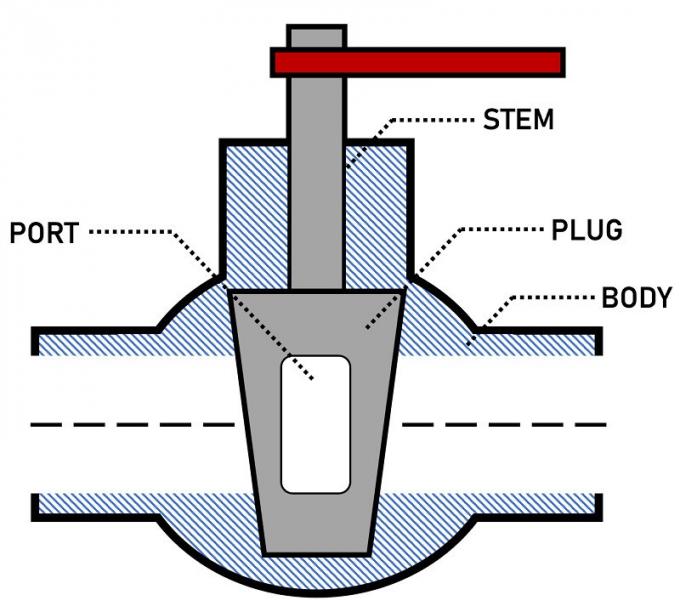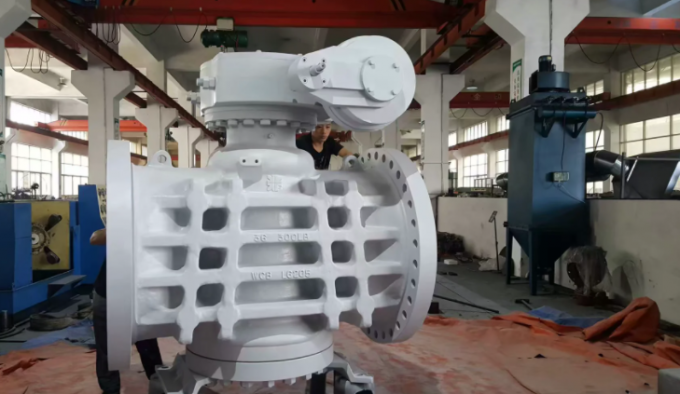What Is Plug Valve?
The Plug Valve is a control device designed to regulate the flow of a gas or liquid within a high-pressure structure also for controlling the flow via moderate throttling, these valves are used in on/off position else to divert flow or combine flow.
Plug valves are the vital part of a hydraulic system which works to keep the entire system function efficiently. Valve Manufacturers usually prefer cylindrical or conical design. Present inside the valve is one or more hollow chambers that basically allow flow through the valve when opened since they are most commonly a double port system with an open position that allows for the flow, and a closed position to stop the flow. EDVC Plug Valves are manufactured as per the industry standards that are of perfect design and functionality.
How Does A Plug Valve Work?
A plug valve is based on a plug with a hollow passage in the valve body. The quarter-turn motion creates an alignment between the pipe and the hole, leading to an open state. When turned to a 90-degree angle from the open position, the valve sits across the pipe leading to a closed state.
Plug valves are available in a variety of different styles and port openings through the plug.
Two-Way Plug Valves: The design allows for a closure element in the middle (a plug and a sleeve), along with a straight through, two-way service for the open and close function.
Three-Way Plug Valves: These valves include a third port, which typically sits at a right angle from the inlet. These plug valves can help in diverting flow (entry from inlet directed between one or both outlets) or combining flow (entry from the two inlets channeled into a single outlet).


What Is A Plug Valve Used For?
Plug valves are an excellent option for many commercial and light industrial applications, including directional flow control, handling of gas or liquid fuels, regulating fluids with suspended solids, such as slurries, or handling low-pressure, low-temperature services.
Due to their smooth design, inline maintenance capabilities, leak-tight service, minimal resistance to flow, and multi-port design options, plug valves find application across a multitude of sectors and systems.
Types Of Plug Valves
Plug valves are available in various types as given below:
Lubricating Plug Valve
Non-Lubricating Plug Valve
Multi-Port Plug Valves
Eccentric Plug Valve
Expanding Plug Valve
1. Lubricated Plug Valve
As the name suggests, a lubricated valve uses a lubricant usually made up of a base oil and viscosity improver (like amorphous or fumed silica) that is injected under pressure between the plug face and body seat to reduce friction and seal ports.
Valve manufacturers generally recommend lubricant suitable for the process fluid, and the valves often must be resealed after only a few cycles, and in some cases, after every cycle. Considered a high maintenance plug valve, they are often used in applications that have infrequent operations.
Lubricated plug valves perform well in processes that utilize fluids that carry mildly abrasive particles such as dirty upstream applications, gas pipeline systems that need bypass valves, and blow-down valves on valve stations and kicker valves.
2. Non-Lubricated Plug Valve
This plug valve utilizes a tapered or cone shape that acts as a wedge and presses a polymeric sleeve against the body cavity. The use of the sleeve reduces friction between the plug mechanism and the body.
Non-lubricated plug valves are often used instead of lubricated ones in applications where maintenance needs to be kept to a minimum, such as special services in Sulphur, hydrogen fluoride, or where liquids could be trapped or solidify and potentially jam the valve.
However, non-lubricated plug valves are limited by the temperature and chemical compatibility of the non-metallic materials they are made of.
The three main types of non-lubricated plug valves are:
Lift-type plug valve
Elastomer sleeved plug valve
Fully lined plug valve
3. Multi-Port Plug Valves
Here you can see the 3-way multiport plug valve. The top image is of 3-way 3-port design and the bottom is a 3-way 2-port design.
Multiport valves are used in transfer lines and for diverting services. A single multiport valve may serve the purpose of three or four gate valves or other types of shutoff valves.
However, sometimes the multiport valve does not completely shut off flow. Great care should be taken in specifying the particular port arrangement for proper operation.
Play
Unmute
Loaded: 100.00%
Remaining Time -0:08
Auto(360pLQ)
ShareFullscreen
4. Eccentric Plug Valve
The design of this plug valve uses a half plug that is advantageous for applications needing a higher seating force with minimal friction from the open to the closed position. The torque seated valves also feature improved shut-off capabilities.
Eccentric plug valves are used for a wide range of flow control and isolation applications including clean and dirty water, sewage, sludge and slurries, air, and other services.
5. Expanding Plug Valve
This complex plug valve uses multiple components that allow the valve to mechanically expand and give it a true double block and bleed function in one valve. The plug valve uses a mechanism that rotates between the open and closed positions and protects both seals from the flow path.
During rotation, there is no contact between the body and seals, and slips expand onto the body seat when the valve is closed to avoid causing any wear or abrasion to the seals. They are often used to prevent product contamination in applications that do not require double isolation.
Plug Valve Disk Types
Plugs are either round or taper cylinders. They may have various types of port openings, each with a varying degree of the opening area.
Rectangular Port is the most common for a plug valve. The rectangular port represents at least 70% of the corresponding pipe’s cross-sectional area.
Round port plug has a round opening through the plug. It is available in full bore and reduced bore design. Valves with reduced ports are used only where restriction of flow is not important.
Diamond Port plug has a diamond-shaped port through the plug. All diamond port valves are venturi restricted flow type. This design is for throttling service.
Plug Valve Applications
Plug valves are commonly used in low-pressure-low-temperature services, although some high-pressure-high-temperature designs also exists.
Plug valves are high-capacity valves that can be used for directional flow control, even in moderate vacuum systems.
Plug valves can efficiently handle gas and liquid fuel.
Plug valves can safely handle extreme temperature flow, such as boiler feed water, condensate, and other such elements.
Plug valves can be used to regulate the flow of liquids containing suspended solids, for example, slurries.
Advantages And Disadvantages Of Plug Valve
Advantages:
Plug valves have simple design with few parts.
Plug valves open and close easily (except large dimensions).
Maintenance and repair of plug valves can be done at the place of operation.
Plug valves have low flow resistance.
Plug valves provide reliable leak- proofness.
Disadvantages:
Because of high friction, first movement (opening-closing) requires a large amount of force.
NPS 4 (DN100) and larger plug valves require a gearbox or an actuator.
Plug valve transitions are narrowing flows due to conic plug.
Generally, plug valves costs are much larger than ball valves.
